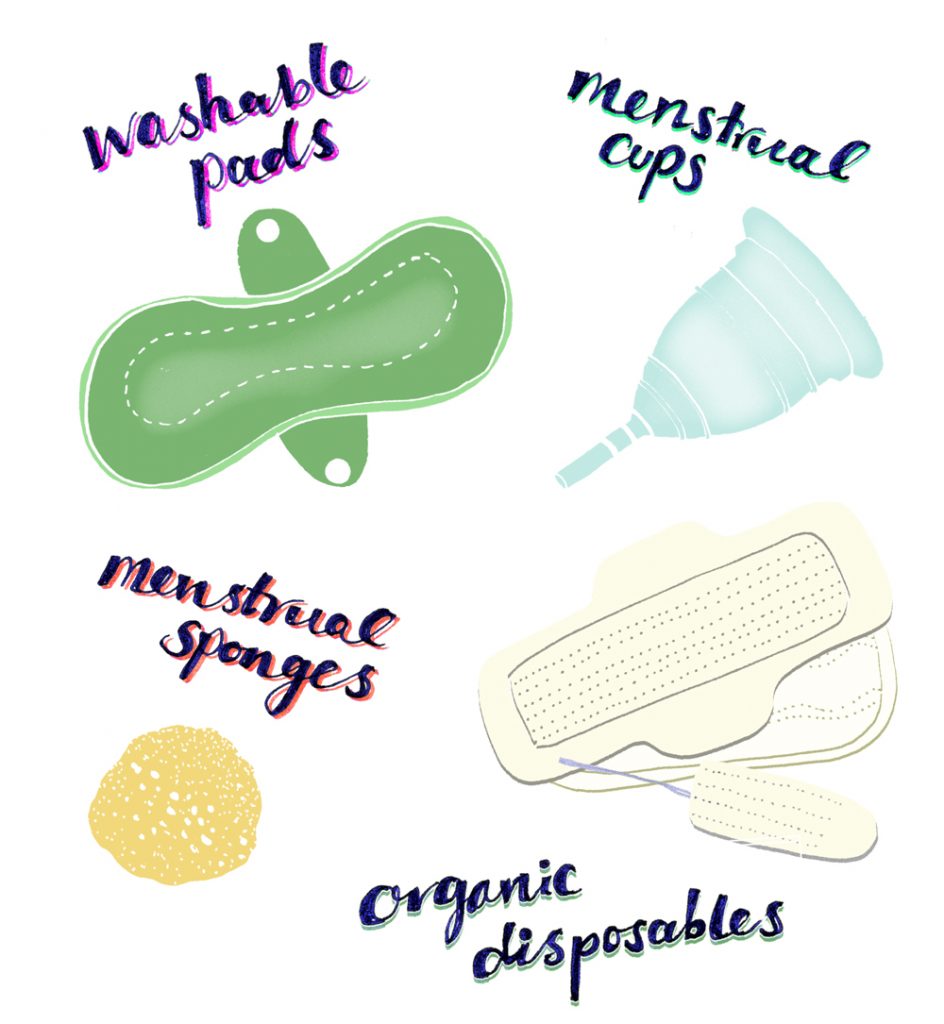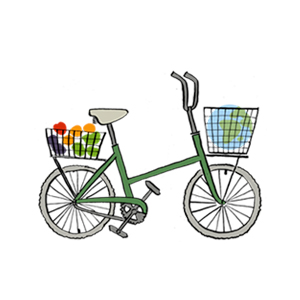NB: This guide contains a few affiliate links, all marked with an asterisk (which is one of these lovely little stars*). If you buy a product after clicking through on an affiliate link, The Green Shopper will make a tiny commission. This is put towards the running costs of this website and further research into ethical shopping options, and won’t cost you a penny.
The average woman spends 6.5 years of her life menstruating, and uses around 11,000 disposable menstrual products¹. Despite advice from water companies and manufacturers, 1.5 billion are flushed away in the UK every year. As well as contributing to ‘fatbergs’ in our sewers, many end up in the sea and on our beaches. On a trip to the Sussex seaside, it was hard to explain to my 3 year old why I didn’t want him to add an attractive looking pearly pink tampon applicator tube to his collection of tidal treasures.
When I found out that mainstream brands of pads are made from up to 90% plastic² I switched to using plastic-free organic cotton disposable pads. It took another decade for me to start using washable pads, but now I’m a convert and I want to spread the word about how comfortable, convenient and economical they are.
With a huge range of washable pads, menstrual cups, period pants and even natural sponges to choose from, it can be hard to know where to begin, so I’ve made this handy guide:
 Washable Pads
Washable Pads
Washable pads can be made from many materials, including wool, cotton, velour, polyester or bamboo fleece. Some contain a thin layer of plasticised fabric such as PUL or an absorbent layer of microfibre. I usually bleed for 5 days and find my stash of 14 pads is enough. I rinse them after use and keep a lidded bucket to soak the pads in the bathroom, then do one wash per month at the end of my cycle.
If you choose pads which contain polyester fleece or other plastics, you may want to consider using a Guppy Friend* wash bag to help prevent microplastic pollution.
My total favourite is made by Honour Your Flow and is a soft cotton fleece pad with a felted wool backing. It is completely plastic-free, apart from the poppers—I’ve used it on my heaviest days and it just keeps on absorbing. They make a great selection of pads, available in UK dress sizes so it’s easy to find a good fit. I’ve also got two sizes of Imse Vimse organic cotton pads*. Their clever design can be poppered completely shut, which is great for transporting used pads home when you’re out and about.
Ethical Superstore do a range of washable pads made from organic cotton by Imse Vimse*. They even make reusable tampons!
Menstrual Cups
If you’re looking for a zero-waste replacement for tampons, the menstrual cup is a great option: a soft washable cup which sits over your cervix. Different brands have slightly different capacities but they can hold between 20-30ml of blood and can go up to 12 hours before emptying. Because cups catch menstrual blood rather than absorb it they don’t interfere with your other vaginal fluids, so they can help prevent the vaginal dryness that some people experience during their period. Once a month your cup needs to be sterilised by boiling or using a sterilising solution. With proper care, a menstrual cup can last for years, which makes it a great choice for plastic-free periods. Mooncup and Organicup* are both made from medical grade silicone. TOTM* have three sizes of cup made from medical grade TPE (Thermoplastic Elastomer). MyCup has written this guide to the differences between silicone and TPE. For a natural and plastic-free option, Fair Squared have created a cup from 100% natural Fairtrade certified rubber*.
I took this online quiz from Put A Cup In It to see which is most suited to my body type. It came up with the Saalt Cup Soft. Saalt kindly gifted one for me to try and it is great! It’s much softer than my previous cup, which I needed to replace after a baby squeezed through my cervix. Saalt also have a handy quiz to see which model is the best fit, which you can find here.
Natural Disposables
Sometimes you need a back-up plan, and using plastic-free disposable menstrual products is a good option for holidays and lazy days. Ethical Superstore* sells organic tampons and organic cotton pads.
Grace & Green are a new brand, with stylish modern packaging and a strong sustainable ethos. All their pads are made from certified organic cotton, and the packaging is made with bioplastic film. You can buy them from Ethical Superstore here*.
TOTM* offer a subscription service to have your choice of organic cotton disposables delivered monthly, or as a one off purchase. They also do a workplace scheme for employers. The world would be a better place if all places of work offered free natural menstrual products! If you are an employer, get in touch with TOTM ASAP!
If you like applicator tampons but hate waste, D.A.M.E sell a reusable tampon applicator*!
Period Pants
I was lucky to be gifted some period pants from the German brand Kora Mikino. I’m happy to report that they are amazing! Manufactured in Germany, with a good ethical policy, the main ‘pants’ are made from super soft tree-based MicroModal and they are SOOOO comfy. If you normally wear pads, it takes a bit of getting used to the feeling of not having something there, but is very liberating once you have acclimatised. I put them to the test on my heaviest flow, and also on a night out dancing, and feel confident in saying they worked perfectly.
WUKA* are a UK based brand who make lots of different sizes, including a special range for ‘tweens’. The wonderful Ali from Incredibusy has written a more in-depth review here.
Cocoro* are a sustainable Spanish brand who make their gorgeous organic cotton period pants in Barcelona. They also have a matching bandeau style crop top.
ModiBodi are an Australian brand who make a huge range of period pants, as well as leak-proof swimwear and maternity vests.
FLUX Undies* also look like a good option for period pants, with Oeko-Tex certified fabrics and an ethical manufacturing policy.
The UK based reusable baby wipe company Cheeky Wipes have started making pads and pants now too.
A bit more info…
I worked with Ethical Consumer to produce a new guide to menstrual products which you can find online here.
If you’re in any need of further persuasion, Earthwise Girls has made this useful price comparison guide to show how much you could save by making the switch:
A cost comparison over five years (60 periods) of using each option:
- Menstrual Cups £9 (around 15p per month)
- Reusable Sanitary Towels or Pads £30 – £70 (50p to £1.16 per month)
- Menstrual Sea Sponges £50 (83p per month)
- Disposable Sanitary Towels/Tampons/Pantyliners £120 – £300 (£3 to £5 per month)
There are a lot of great initiatives to help raise awareness of plastic free period options, tackle period poverty and end menstrual shame.
- Bloody Good Period is a project that donates menstrual products to asylum seekers and refugees.
- The Women’s Environmental Network Environmenstrual campaign is amazing! They are working together with City To Sea’s Plastic-Free Period campaign.
- The Real Period Project are an organisation dedicated to wellbeing thjrough menstrual education.
- Hey Girls offer a ‘buy-one-give-one’ policy for all pads bought from their site.
- #PeriodPositive is an amazing campaign to raise awareness of menstrual issues and tackle taboos.
- Ella Daish’s #EndPeriodPlastic campaign is inspirational! Sign her petition here: https://www.change.org/p/make-all-menstrual-products-plastic-free
I know I feel a lot more positive about my period since switching to reusable menstrual products—do you dare to make your period plastic-free too?
- https://www.mooncup.co.uk/why-mooncup/why-should-i-use-a-menstrual-cup/
- http://www.natracare.com/why-natracare/plastic-free/

Nice rundown of all the options for eco-friendly period prodcuts! My personal favourites are a menstrual cup (I used the Sckooncup) paired with reusable cloth pads (Blushing Bluebirds from Canada). I LOVE that I’m not throwing stuff into the trash every single month. It’s also an excellent way to save money as well.
Thanks for the mention 🙂 you blog looks great!
Menstrual cups are the most eco-friendly option – 15 gms of silicone every 10 years. ( About the same as a crisp packet.) Why no picture of a menstrual cup? They should not be boiled for 10 minutes, that will wear out the silicone quicker. 1 minute is enough to kill any germs ( which belong to the user anyway) and current research i s investigating if boiling at all is necessary. ( Who boils a sex toy? Or a contraceptive cap?)
Sponges can lead to Toxic Shock Syndrome – bits fall of them and remain inside. Also difficult to wash out properly, and like tampons absorb the ‘ good fluids’ from inside the vagina.
Thanks for commenting Janie, I’ll change the advice about boiling times! There is a picture of a menstrual cup in the top right of the illustration 🙂 I’ve never tried menstrual sponges, so it’s interesting to hear some user feedback…
Ah yes, the picture of the Menstrual Cup has now APPEARED! They don’t ” fit snugly over the cervix”. A cup sits inside the vagina, below the cervix. This is why it can hold menstrual fluid up to 12 hours, or 3 tampons worth.
My 13yo started when she was just turning 11, she’s now 13 and uses pads. I’ve suggested period pants but they’re an expensive option if she doesn’t like them, so that only leaves pads, also expensive. I think we’ll try 50/50 until she’s more confident about using anything else. Any suggestions welcome.
Hi Pam, thanks for getting in touch. You could try just buying one washable pad or pair of period pants to see if they work for her. Even just using them at home or at night will save on waste! Otherwise just sticking to natural disposables will still make a difference. TOTM are great, there’s a link in the article. Best of luck!
I can’t believe I got to mid forties before it occurred to me to try different options, but I’m finding the mooncup brilliant! Recommend getting used to it at home first, but then it holds so much more than a tampon (and no sudden clot issues) and periods feel much more manageable. My daughter just started and we bought just one pair of period pants to try, and so far they seem so good she said she forgot she was on her period at school. Just ordered another, and will build up supply if she continues to like them. Sharing this as both of these I thought would be better for the environment, but hadn’t realised they’d make periods easier too.